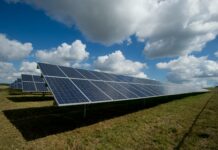
Climate change and the risk of global warming are forcing countries to explore new and more sources of clean and renewable energies. Several countries are heavily investing in the development and adoption of renewable energy technologies including wave energy. Wave energy refers to the kinetic and potential energy captured within oceanic and sea waves. As more than 70% of the earth’s surface is covered by water bodies, wave energy is one of the most abundantly available renewable energy generation technologies in the coming future. It is an underexplored renewable energy generation technology with huge potential. To harvest this energy, Wave Energy Converters (WECs) are installed at shorelines, nearshores, and offshore locations to absorb the energy from the incoming waves and generate electrical or mechanical output. It is an oscillating and irregular low-frequency source of energy that can be converted into 60-Hertz frequency and can then be added to the electric utility grid with the help of wave energy converters.
Oscillating Body Technology Dominates Among the Other Wave Energy Converting Technologies
There are four different technologies that govern wave energy converters: oscillating water columns, oscillating body converters, overtopping converters, and rotating mass. The wave energy converters operating on the principle of oscillating body technology dominate the other wave energy converting technologies. To ensure high energy generation, these WECs are made large in structure, enabling the capturing of a large quantity of air. An added advantage of this type of structure is its capability to be clubbed to form a chain or farm, enhancing its power generation capability to match utility scale standards. Furthermore, a chain of these large structures can be used to avert coastal erosion and reduce the impact of sea waves on the shore, ultimately helping in environmental protection.
REGULATORY FRAMEWORK IS EVOLVING
Being at the nascent stage, it does not have a properly defined process to pass through the bureaucratic formalities. Currently, there are no central licensing agencies that can direct the agencies involved and not any official licensing procedure for prototypes or pilots. The fact that wave energy, along with other ocean energies, is dependent on geographical settings, a predefined zoning plan can help this sector to overcome its local impediments. At the same time, people who are engaged in traditional marine activities and coastal communities tend to be suspicious of the impact of these new wave energy activities. Therefore planning and licensing processes for ocean energy need to be open and comprehensive enough to take such issues into account. The lack of planning and licensing processes in marine activities of areas where several interests (energy, tourism, transport, fisheries, etc.) are concerned tends to increase risks and uncertainty of failure or delayed projects at sea.
MARKET OUTLOOK
The global wave energy converter market is projected to grow from an estimated USD 20.3 million in 2022 to USD 28.6 million by 2030, at a CAGR of 4.3% from 2022 to 2030. Their future outlook for the companies operating in the wave energy conversion market is positive but it is important to note that this is still an emerging industry with some significant challenges. Success will have to depend on several factors, including advancements in technology, government support, market demand, and competition from other renewables. Any technological breakthrough in this market is likely to lead to a significantly higher growth rate than projected. The growing power demand from coastal communities and the ample availability of wave energy resources drive the WEC market. Likewise, increasing R&D investments and the growing focus on clean energy generation offer excellent opportunities to this market.
Eco Wave Power (Israel), SINN Power (Germany), Carnegie Clean Energy (Australia), CorPower Ocean (Sweden), Ocean Power Technologies, Inc. (US), and AMOG Consulting (Australia) are the key manufacturers of wave energy converters. They have comparable strengths in terms of customer bases, diversified product portfolios, technological capabilities, and diversified regional presence.
WAVE ENERGY POTENTIAL IS GEOGRAPHY AND LOCATION SPECIFIC
The energy density of the waves can vary based on the location. North America, Europe, and Asia Pacific have the best wave conditions for use. Ideally, medium-high latitudes and deep waters (greater than 40 m deep) are considered to be the best for generating wave energy as these conditions can lead to power densities as high as 60 to 70 kW/m. Australia, Chile, Ireland, New Zealand, South Africa, the UK, and the US have excellent wave resources with average power densities of 40 to 60 kW/m.
By Location
The installation locations of WECs differ based on the type of wave energy converter. For instance, stationary oscillating water column WECs and a few of the oscillating body WECs need a solid base to be installed. This makes it necessary to install these wave energy converters on the shore or near it. Likewise, floating oscillating water column WECs, overtopping WECs, and a few oscillating body WECs can be installed in offshore locations. The offshore segment is expected to grow at the fastest rate from 2022 to 2030, offshore wave energy converters can harness the most amount of wave energy as wave energy resources are strongest in offshore locations.
By Region
Europe accounted for the largest share and is projected to be the fastest-growing region of the wave energy converter market from 2022 to 2030. Europe has imposed stringent environmental regulations for controlling the carbon emissions from power generation activities. In line with that, the region focuses on enhancing electrical power generation from renewable energy sources such as waves and wind. The presence of a large number of companies working in the research and development of wave energy converters in the region is expected to drive the wave energy market in Europe. Major countries in this region include the UK, Portugal, France, and Denmark.
Key Barriers and Challenges Must be to Harness the Abundant Untapped Potential
Wave energy has enormous potential. However, there are techno-commercial barriers and challenges faced by wave power. This includes the development of technologies that can withstand extreme ocean weather and harsh environmental conditions, energy storage, and the consistency of supply in sufficiently substantial volume. Most of the players that offer WEC technology are currently working on their pilot projects. A significant investment in research and development is needed to make wave energy commercially viable and cost-effective. Several researchers are studying various parameters corresponding to the viability of WEC and how their costs can be brought down without compromising efficiency. The breakthroughs overcoming these barriers and challenges can establish wave energy among the prominent sources of renewable energy such as solar and wind and can help in the energy transition toward achieving carbon neutrality by 2050 and a net-zero emission goal by 2070.
















